Last Commanders: a geeky new Knightmare-esque gameshow
CBBC’s Last Commanders, starting today, is an ace new kids’ gameshow set in a dystopian sci-fi universe…
Switch off jealousy. Switch off anger. Switch off sadness. Achieve Perfection.
Space. The future. The Kaladian people have been enslaved by a rogue A.I. named Sciron. Programmed to protect Kaladians from The Sickness, Sciron created a virus to make them invulnerable to disease. Instead, the virus shut down their emotions and turned them into mindless, controllable husks.
At the Ykarus Biotech station, scientist Dr Kline does Sciron’s work spreading the Perfection Virus throughout the population. Only the two per cent of naturally immune Kaladians still retain their free will. Led by genius coder Skye, these Freedom Fighters need to battle their way past robot soldiers the Cybers and mutant Morkas to defeat Kline and Sciron, retrieve the antivirus, and save their people.
They can’t do it alone. The Freedom Fighters need a highly specialised kind of help from a very particular source. Who? Earth children, aged eight and over. Where? Sitting on their sofa, shouting excitedly at a laptop. This is CBBC’s ace new sci-fi gameshow Last Commanders, a twist on studio adventure games where teams play from home all over the UK.
“The idea,” explains the show’s Development Producer Ryan Meloy, “was to be as inclusive as possible, but also to mimic a natural video gaming environment – sitting in your bedroom with your friends.”
Soon, you’ll be perfect too. 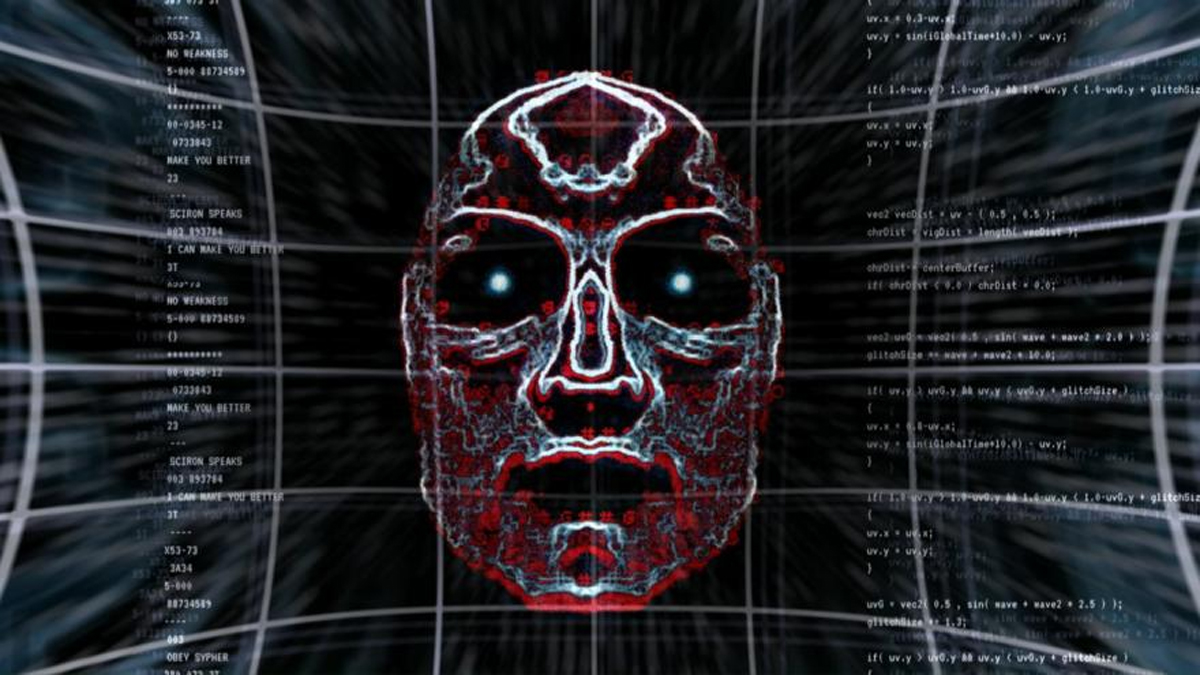
Linked remotely to the Glasgow studio in real-time, the young teams interact with their chosen live-action ‘avatar’ (selected video game-style from a list of eight different players, each with their own distinctive style and attributes) via a computer. A first-person game, they see what their head-cam-wearing avatar sees, and instruct them through the mission through a series of puzzles and high-tension pursuits.
“It’s literally just them playing the game with their friends,” says Meloy. “There’s no-one in the room producing them or distracting. They’re using a ‘Mission Pack’ with a laptop that we send out to their house, they just have to switch it on – it’s very Mission Impossible!”
“Once the game starts – it doesn’t stop, adds Series Producer Lou Brown. “We don’t break recording, it’s shot like a live show. The Freedom Fighters hear a feed from the players in one ear and directions from the gallery in the other.”
The remote play makes Last Commanders much more accessible than a studio-based game. “Kids in the regions who might normally struggle to travel to a studio were able to play, kids with disabilities could play, kids who might otherwise be camera shy or intimidated by the studio environment could play…” Meloy tells us.
“We were able to cast kids in Wales, Northern Ireland, England and Scotland as a result of the technology, says Brown. “And the kids weren’t even required to take time off school.” Phew, lucky them.
Help us, please, before she comes for you. 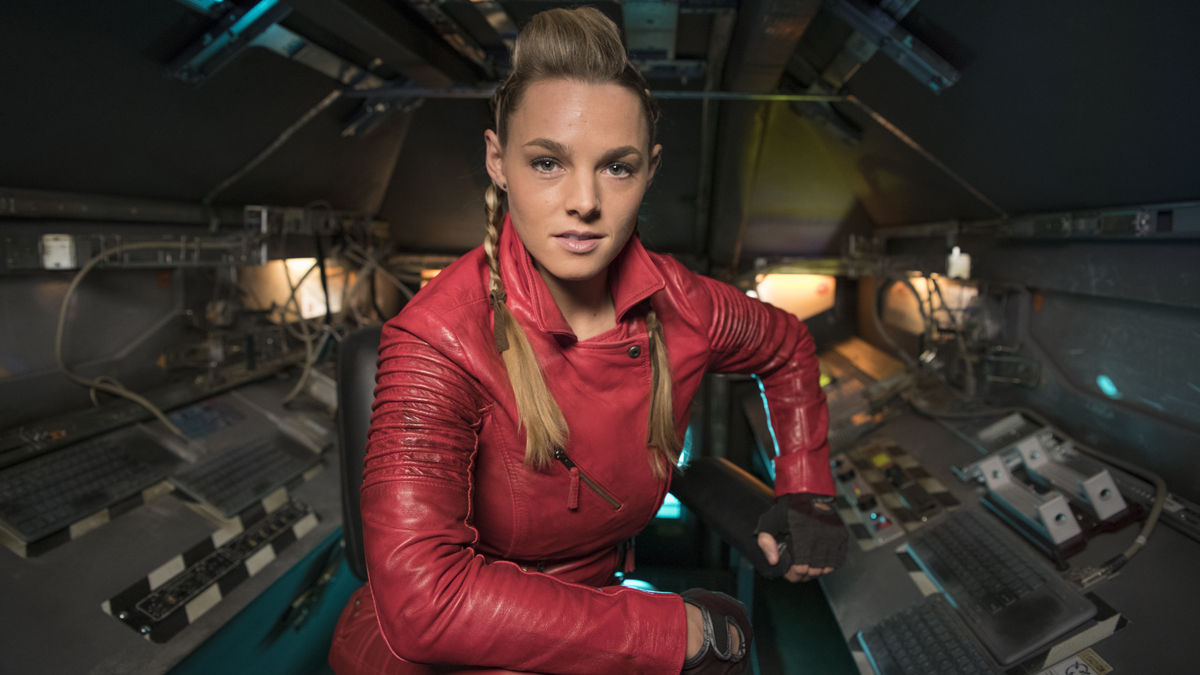
Luck doesn’t come into Last Commanders. It’s a game of skill and keeping a cool head. Similar to an Escape Room, or live-action point-and-click game, kids have to explore their avatar’s environment and work out the solutions to puzzles to unlock doors and items as they make their way around the space station. A good eye, a keen memory, logic and a bit of creativity is required.
“Much like a video game, says Meloy, “there were multiple solutions to a lot of the puzzles, some that we’d pre-empted but others that came out of the blue and were just ingenious.”
It’s an ongoing story, in which each episode takes place in a new area of the space station. “The one thing we wanted to do from the very beginning was merge an ongoing drama format with a gameshow format,” says Meloy. “Budget-wise,” adds Brown, “it is a mid-priced CBBC show. It is about half the cost of an on-going drama, but about double the cost of a quick turnaround studio game show.”
Video games were a key inspiration. A child of the nineties, Meloy grew up playing games from “the point-and-click golden age”. He has fond memories of Grim Fandango, Full Throttle, Day Of The Tentacle, “but the game I really love and still return to is Broken Sword: The Shadow of The Templars. Oh, and Westwood’s Blade Runner – someone needs to remaster that in HD!”
The Lucas Arts games were a particular influence on the show in terms of storytelling and puzzle design, as were the first two Resident Evil games on the PS One. “The kids in Last Commanders only get one chance, or one life, to complete their mission,” he says, a choice influenced by Resident Evil’s Ink Ribbon save system. “I remember my brother and I playing Resi 1 without a memory card and the further in we got, the more intense things became as there was no safety net,” he says. “That same underlying tension really drives up the excitement.”
She reprogrammed the Cybers to control us. 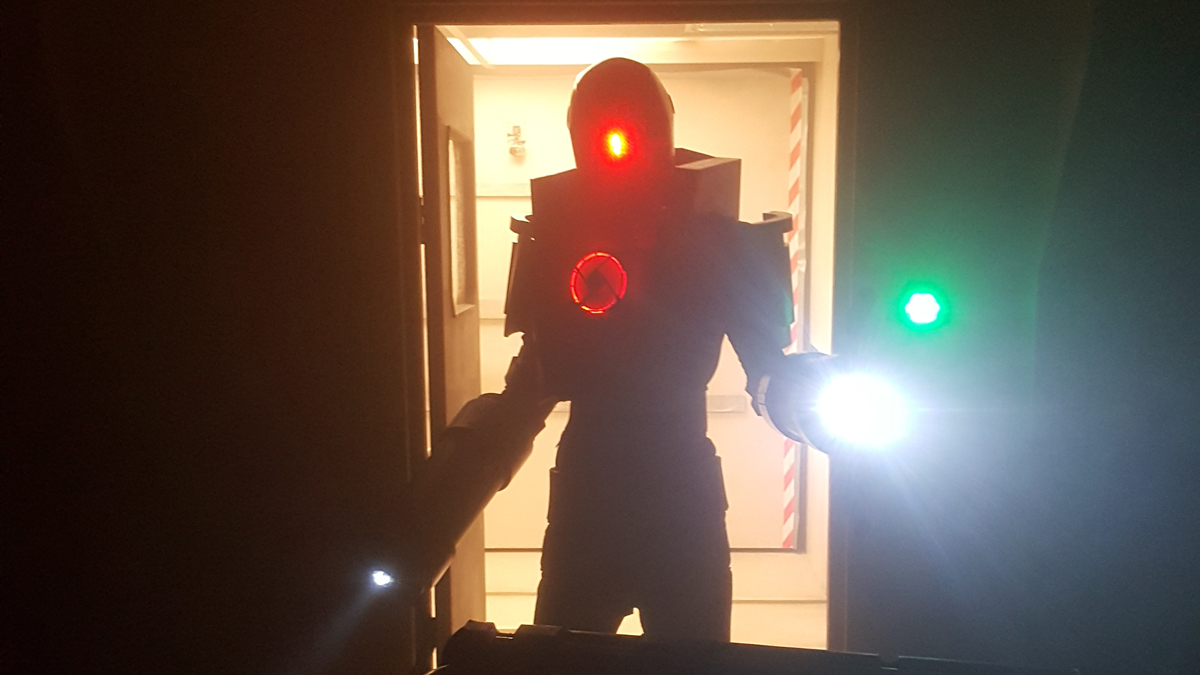
Part of that excitement comes from Last Commanders’ scarier elements – the patrolling ‘Cybers’, the all-seeing Sciron, and sinister mutants the Morkas.
“Because of the First Person perspective,” says Meloy, “we felt that there was a real opportunity to dial up the scares – a kind of found footage horror for kids, if you like! Not knowing what’s behind you at any given time creates a sense of paranoia, panic and unease.”
That much is clear from the players’ reactions to the chase sequences. “We knew the Cybers and other enemies would be scary,” he says, “but the excitement and reaction of the kids was so much better than we ever thought it would be. A few times throughout the production run the sound levels had to be readjusted as the children were getting so excited and screaming so loudly!”
It was all a matter of finding the right balance of threat and thrill for a young audience. “Although we knew that Last Commanders would probably appeal to the older end of the CBBC audience,” says Lou Brown, “we were aware that we would have younger viewers too, so we had a responsibility to them too.
That said, the aim was to make Sciron “an intimidating, threatening presence,” says Brown. “Dr Kline evolved, we felt he would be scarier if he wasn’t a pantomime evil villain, instead he is fighting for a cause that he believes in… albeit a disturbing cause!” Sciron’s Perfection regime, Brown tells me, is fascist. The posters spotted around the Biotech station were designed “to have a sinister nod to fascist propaganda.”
The Ykarus Biotech station was my home. 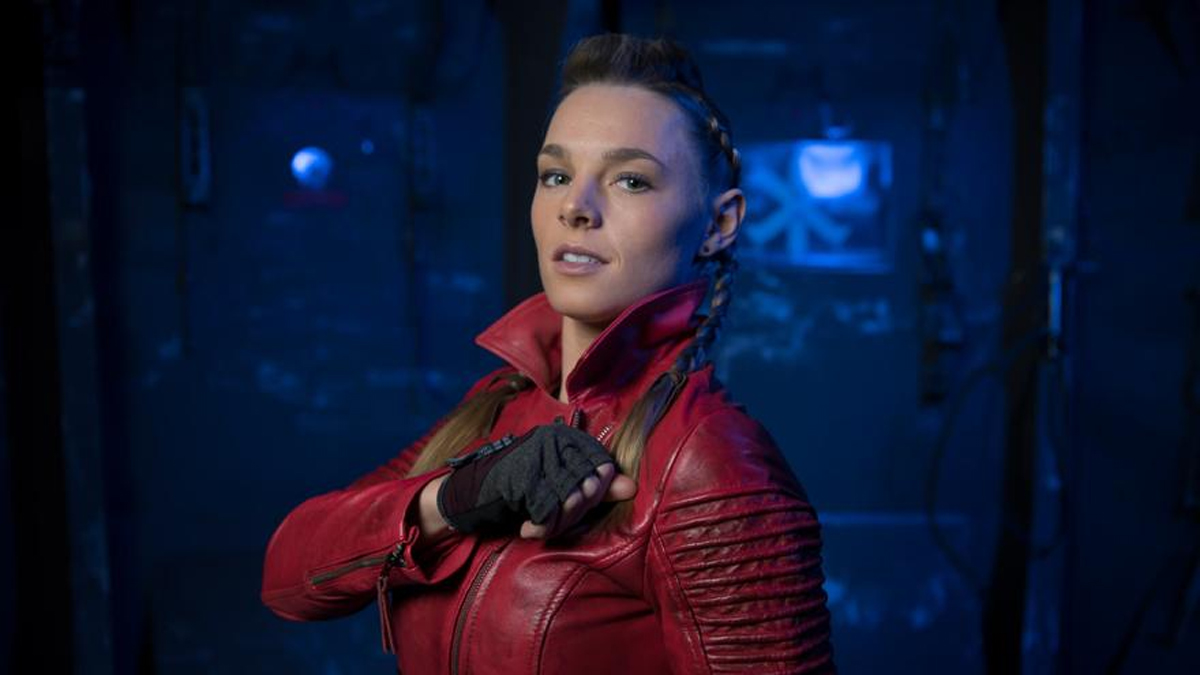
When it came to designing the look of the Ykarus, “it was a case of capturing that aesthetic of first person video games,” says Meloy, “compact corridors and labyrinthine environments that at times feel claustrophobic. We wanted the show to look like a hyper-real video game. So a lot of the early reference images came from those corridor crawling FPS games and classic sci-fi films. This also gave us scope to put in secret passages, escape hatches, ventilation shafts, trapdoors…”
“We wanted the space station to look a bit old and lived in,” says Brown, “Red Dwarf and Guardians Of The Galaxy were references.”
Production Designer Moley Campbell and his team put meticulous work into the sets and props. “I was looking through some of Moley’s sketches the other day,” Meloy tells me, “and he’d written up the schematics to the Invisibility Band and the science behind it!” The Invisibility Band—a prop that appears in episode one—underwent a last-minute redesign, Brown says, “about three hours before our first record, because the original looked like a female personal hygiene product!”
A crucial part of the Last Commanders atmosphere is down to the show’s music. That came courtesy of HyperDuck Soundworks. “I was aware of them from playing Dust: Elysian Tail on PS4,” says Meloy, “which is one of my all-time favourite video game soundtracks.”
But two per cent of us are immune, and we’re fighting back 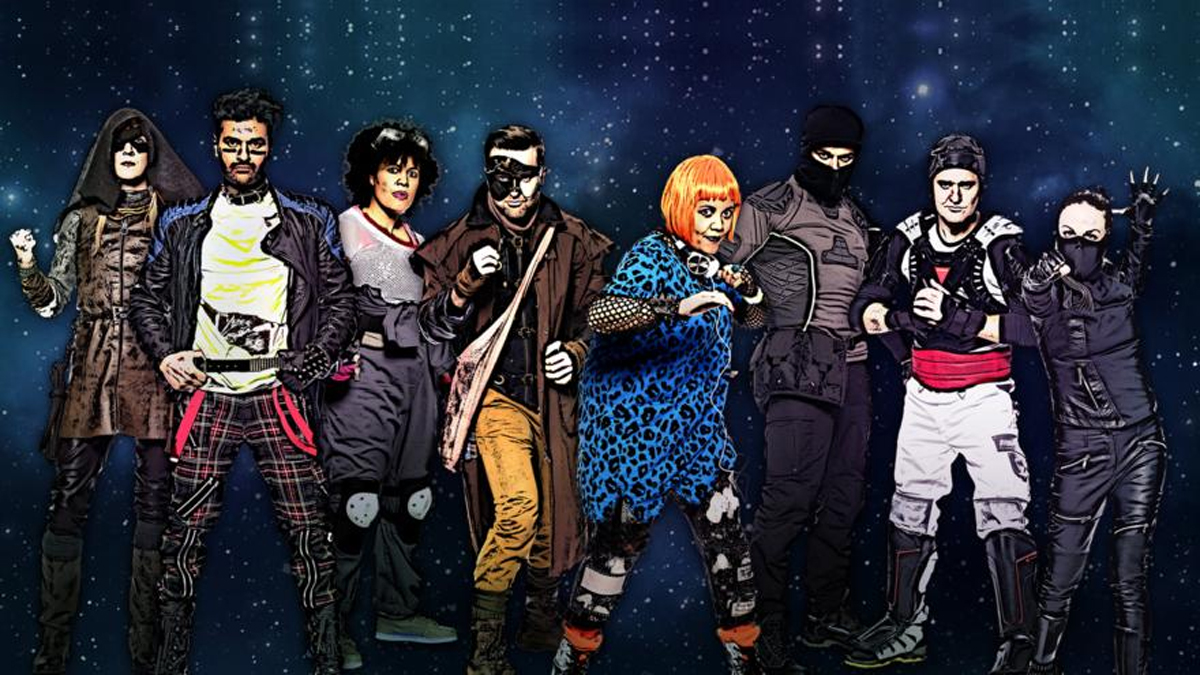
Last Commanders’ sci-fi story influences range far and wide. Battlestar Galactica, Invasion Of The Body Snatchers, The Tripods, “even CBBC’s The Demon Headmaster!” played their part in the virus premise, says Meloy. “Then it was a case of taking more colourful and brighter influences from the likes of Doctor Who, and even things like Halo and Star Wars Rebels and injecting a more comic book tone.”
That combination of video game and comic book influences is carried through the eight avatars from which teams of commanders choose their Freedom Fighter: Catara, Dexx, Tal, Vaygus, Brodie, Makira, Venvvo and Zarq. “There are clear influences from the likes of Street Fighter, Mortal Kombat, Streets Of Rage,” says Meloy.
The character linking the teams to their avatars is Skye, played by Zoe Barker, an in-world guide – Last Commanders’ Treguard, if you like. (Meloy is secretly hoping, he confides, for Skye’s sign-off, a fist-to-chest salute and the words “For freedom!” to become “a war-cry in playgrounds across the country!”)
Skye’s character was originally conceived as male, “a Han Solo type” says Brown. “Then he evolved into being more of an Obi Wan character, then more of a sexless Ziggy Stardust character.” The persona they landed on was a genius coder with a “kind of cyber punk aesthetic,” says Meloy. “Her costume was initially going to be in the mould of a rebel pilot fighter but in the end it has has elements of Akira’s Kaneda, among other things. I think all of us were doing our best to get little nods in there from our favourite pop culture references!”
“A lot of the episodes are loosely based on a different film,” he continues. “Climbing through the vents is clearly inspired by Die Hard. There’s an episode where the Avatars meet a fellow freedom fighter NPC – we approached this as if it were our Ico episode with co-op puzzles.”
Perfection is here. 
A rich, nerdy brew of influences is clearly behind Last Commanders, not least of all the children’s narrative gameshow a whole generation holds close to its heart: CITV’s Knightmare. Lou Brown describes her colleague Ryan as “a crazy Knightmare fan, so that was a huge influence”.
“I loved Knightmare, obviously, so making a show like this is something I’ve dreamed of since I was about ten!” he agrees. “Knightmare was such a departure from other kids’ shows at the time. It felt like a video game brought to life and shared a lot of similarities, puzzle-wise, with the old text adventure games on the Spectrum ZX.”
Who would they recommend the show to? “Anyone from about eight upwards should tune in,” says Moloy. “It might be a little scary for the younger kids.” Older viewers and geek parents too, should appreciate the humour, invention, and subtle geeky nods. “Spotting those can be a little game in itself!”
That’s us sold. For freedom!
Last Commanders’ first episode, The Fightback Begins, airs on Tuesday the 30th of January at 5.30pm on CBBC.
